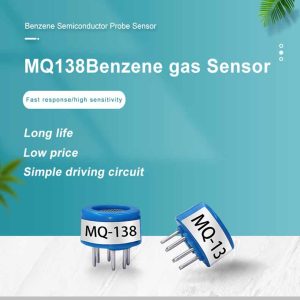-
Monitoring Air Quality: Harnessing the Power of Gas Sensors for Healthier Environments
- Air pollution is a significant global concern, with adverse effects on human health, the environment, and climate change. As urbanization continues to increase and industrial activities expand, it becomes crucial to monitor air quality an……
- Chat Online
-
Description
Air pollution is a significant global concern, with adverse effects on human health, the environment, and climate change. As urbanization continues to increase and industrial activities expand, it becomes crucial to monitor air quality and take proactive measures to mitigate pollution. In recent years, gas sensors have emerged as powerful tools for monitoring air quality in real-time. This article explores the role of gas sensors in monitoring air quality and their potential for creating healthier environments.

The Impact of Poor Air Quality:
Poor air quality poses serious risks to human health, leading to respiratory problems, cardiovascular diseases, allergies, and even premature death. It also contributes to environmental degradation, including acid rain, smog formation, and damage to ecosystems. Monitoring air quality is essential for understanding pollutant sources, assessing exposure levels, and implementing effective strategies to reduce pollution.
Understanding Gas Sensors:
Gas sensors are devices that detect and measure specific gases or volatile compounds present in the air. They utilize various technologies, such as electrochemical, optical, and semiconductor sensors, to detect and quantify pollutants. Gas sensors can measure a wide range of gases, including nitrogen dioxide (NO2), ozone (O3), carbon monoxide (CO), particulate matter (PM), volatile organic compounds (VOCs), and many others.
Real-Time Monitoring and Early Warning Systems:
One of the significant advantages of gas sensors is their ability to provide real-time data on air quality. Traditional methods of air quality monitoring often involve manual sampling and laboratory analysis, which can be time-consuming and may not provide immediate results. Gas sensors enable continuous monitoring, allowing for the early detection of pollutant levels exceeding acceptable standards. This information is crucial for implementing timely interventions and issuing early warnings to protect public health.
Indoor Air Quality Monitoring:
Indoor air quality is equally important as outdoor air quality, as people spend a significant amount of time indoors. Gas sensors can be used to monitor indoor environments, such as homes, offices, schools, and hospitals. These sensors can detect pollutants emitted from various sources, including building materials, cleaning products, cooking, and smoking. Monitoring indoor air quality helps identify potential health risks, improve ventilation, and create healthier living and working spaces.
Urban Air Pollution Monitoring:
Urban areas are often hotspots for air pollution due to high population density, traffic congestion, and industrial activities. Gas sensors deployed in urban environments can provide valuable data on pollutant levels, helping authorities identify pollution sources, implement targeted interventions, and assess the effectiveness of pollution control measures. This data-driven approach is crucial for creating sustainable and healthier cities.
Mobile Sensing Platforms:
Mobile sensing platforms equipped with gas sensors offer flexible and dynamic air quality monitoring capabilities. These platforms can be mounted on vehicles or drones, allowing for monitoring in different areas and at varying altitudes. Mobile sensing platforms enable the collection of data from multiple locations, providing a more comprehensive understanding of air quality patterns and pollutant dispersion. They are particularly useful in detecting pollution hotspots and assessing the impact of industrial emissions.
Citizen Science Initiatives:
Gas sensors have the potential to empower individuals and communities to actively participate in air quality monitoring through citizen science initiatives. Portable and affordable gas sensors enable citizens to collect air quality data in their neighborhoods and contribute to broader monitoring efforts. Citizen science initiatives foster community engagement, raise awareness about air pollution issues, and encourage collective action for cleaner and healthier environments.

Conclusion:
Gas sensors play a critical role in monitoring air quality and creating healthier environments. By providing real-time monitoring, early warning systems, and data-driven interventions, gas sensors enable proactive measures to reduce air pollution's detrimental effects on human health and the environment. As technology continues to advance, it is essential to promote the widespread adoption of gas sensors, strengthen monitoring networks, and foster collaborations between stakeholders to ensure cleaner air for present and future generations.
-
Recommend:
-
-
Gas detectors are crucial devices used in various industrie…
-
How do gas detectors ensure industrial safety?
Gas detectors play a crucial role in ensuring the safety of…
-
How Gas Sensors Help Combat Air Pollution?
Air pollution is a pressing global issue that poses signifi…
-
How can gas sensors be used in air quality monitoring?
Air pollution is a significant global concern that affects …
-
 : +86 155 8830 2704
: +86 155 8830 2704 : jxdziot@gmail.com
: jxdziot@gmail.com
